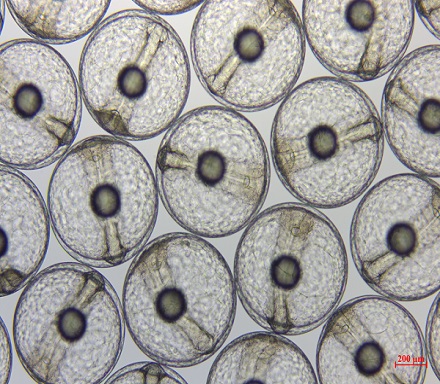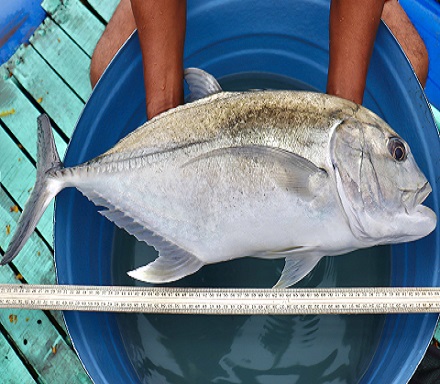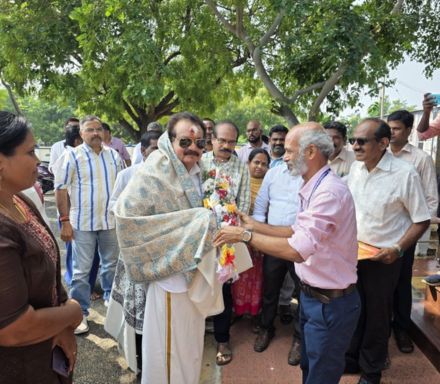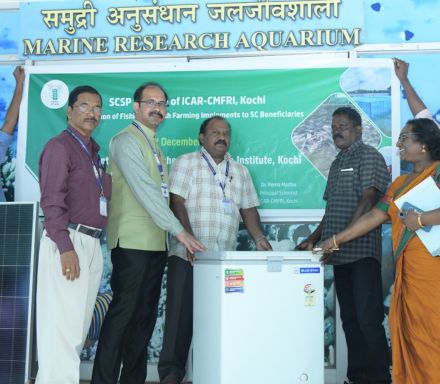

Breakthrough in Mariculture: ICAR-CMFRI achieves success in induced breeding and captive seed production giant trevally-Caranx ignobilis
In a landmark achievement for mariculture research, the ICAR-Central Marine Fisheries Research Institute (CMFRI) succeeded in induced breeding and seed production of the giant trevally (Caranx ignobilis).Giant trevally is a fast-growing, important food fish that can be farmed in marine and estuarine cages, pens and coastal ponds. This fish can grow faster than pompanos and can tolerate wider salinity ranges and water quality conditions.
“The achievement is a breakthrough in mariculture and is a significant advancement in the efforts to sustainably manage and conserve giant trevally as a new candidate species in the mariculture sector”, said Dr A Gopalakrishnan, Director of ICAR-CMFRI.Captive breeding of Giant trevally faced significant hurdles for a long time due to its preference for open waters, specific breeding requirements and complex reproductive biology. This breakthrough was followed by extensive research and trials conducted by scientists at Vizhinjam Regional Centre of ICAR-CMFRI, Vizhinjam, Thiruvananthapuram, Kerala, India, with the funding support of the Department of Biotechnology, Ministry of Science and Technology, Govt. of India. Research was carried out under the leadership of scientists Ambarish P Gop, Dr M Sakthivel, and Dr B Santhosh.
The successful breeding of the species has involved meticulous monitoring of its behaviour, hormone administration and precise environmental control. The research team documented spawning and larval rearing, marking a crucial milestone in understanding reproductive biology, breeding, and seed production technique of the species.Giant trevally is a highly valued game fish and is commercially valued for its firm and excellent flesh quality preferred across the Indo-Pacific region. Belonging to the Carangidae family, this fish is well known for its large size and has immense potential in the mariculture sector, typically found in coastal reefs, lagoons and open seas. The giant trevally is characterized by its silvery colouration with a series of small dark spots and faded vertical bars along its body, often growing up to 1.7 meters long and weighing over 80 kilograms in the wild. This is a much sought-after popular marine fish and its price ranges from Rs 400 to 700/ kg.
Initial cage farming trials with pellet feed indicated that this fish reaches marketable size up to 500g in 5 months and around 1kg in 8 month culture.Juveniles of size 20-35 g were collected from the barmouth area using Chinese dipnet and stocked in ICAR-CMFRI’s Interim Broodstock Rearing Facility located at Prakkulam area of Ashtamudi Backwaters in Kollam district of Kerala. The fish were reared on a special broodstock diet and attained 2.2-3.5 kg size in two years. The maturity stages were determined by cannulation biopsy and the broodstock fish (mature male and female) were identified and transferred to broodstock cages. When the female fish had an ova diameter of 200-280 µm, a few fishes were transferred to the indoor hatchery facility of Vizhinjam Regional Centre of ICAR-CMFRI located at Thiruvananthapuram district in Kerala. At this hatchery, the fish were reared in three RAS systems of 10-tonne capacity at a sex ratio of 1:1 (female: male), and LHRH analogue was used to induce the broodstock. Hormone administration was done in females at a stage with an ova diameter 420-450 µm, and the fish spawned 48-52 hours after the second dose of hormone injection. The eggs were hatched after 14-16 hours post-fertilization and the larval mouth opening was recorded between 64-65 hours. Successful initial feeding was achieved using a calanoid copepod Parvocalanus crassirostris as a live feed, and from five dph onwards, shifted to a mixed diet with rotifer and from nine dph onwards, with Artemia. The larvae started to metamorphose at 18-20 dph and are weaned to pelleted feed during this stage with good survival rate.ICAR-CMFRI now focuses on optimizing the breeding protocols to scale up the production efficiency and refine the larval rearing protocols of this species. Giant trevally is a fast-growing, hardy species that can be easily farmed using pellet diets throughout the culture period. The initial success of the giant trevally's captive seed production is expected to pave the way for large-scale fish seed production and farming of this marine fish.
Reported by
Ambarish P. Gop, Sakthivel, M., Santhosh, B., Surya, S., Muhammed Anzeer, F., Anuraj, A. Krishna Sukumaran, Rathi Bhuvaneswari, Boby Ignatius, Suresh, V.V.R, Aneesh, K.S., Dispin Das, Akhil, A.R., Arshadudeen, M. Ajimi. J.S. & Gopalakrishnan, A. (July, 2024)















